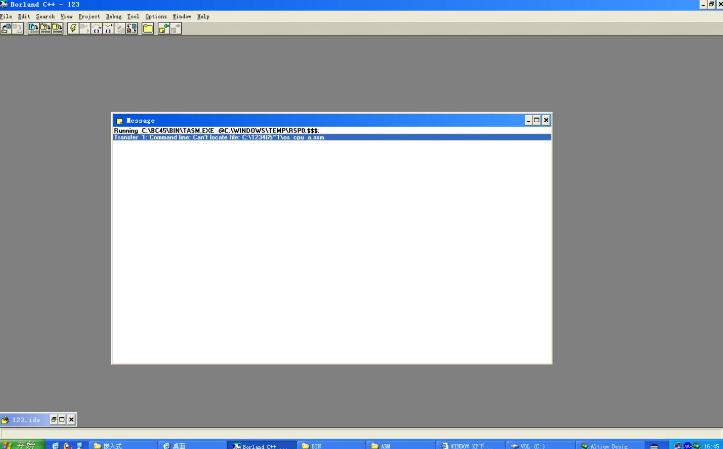borland编译器
软件: borland
Borland Compiler: A Legacy Powerhouse in C++ Development
1. Overview of Borland Compilers
Borland Compiler refers to a family of high-performance C and C++ compilers developed by Borland International, a pioneer in developer tools during the 1980s–1990s. The suite includes the flagship Borland C++ Compiler (BCC) and the companion Turbo Assembler (TASM), both integral to Borland’s integrated development environments (IDEs) like Borland C++ Builder. These tools were renowned for their fast compilation speeds, low memory footprint, and tight integration with other Borland products, making them a staple for Windows and DOS developers.
2. Key Products in the Borland Compiler Suite
Borland C++ Compiler (BCC)
The core C++ compiler in the suite, BCC evolved from early versions (like Borland C++ 2.0 for MS-DOS in 1990) to later iterations (such as Borland C++ 5.5 in 1997). It supported multiple platforms (DOS, Windows 3.x, Windows 95, Windows NT) and C++ standards (C++98, C++03, partial C++11). Notably, Borland C++ 5.5 was the last version to include a standalone command-line compiler (without an IDE), making it a favorite for legacy system maintenance and embedded development.
Turbo Assembler (TASM)

Developed alongside Borland C++, TASM is a high-speed x86 assembler designed for low-level programming. It integrates seamlessly with Borland C++ (via asm{} blocks in C++ code) and supports both 16-bit (DOS) and 32-bit (Win32) applications. TASM 5.0, a landmark version, offered advanced features like macro preprocessing, optimized code generation, and compatibility with Microsoft’s linker (LINK.exe). It remains a go-to tool for assembly language enthusiasts and system programmers.
3. Technical Highlights
Compilation Process
Borland C++ follows a traditional preprocessing → compilation → assembly → linking workflow. For example, the command bcc32 -c Sample.c compiles Sample.c into an object file (Sample.obj), while tasm32 Sample.asm assembles the assembly code into an object file. The linker (tlink32) combines object files and libraries (e.g., EMU.LIB, MATHL.LIB) into an executable.
Optimization & Compatibility
BCC was known for its aggressive optimization (e.g., -O2 for speed, -O1 for size) and support for modern C++ features (templates, exceptions, RTTI). Early versions targeted real-mode DOS (Borland C++ 3.1), while later versions (5.0+) added support for protected-mode Windows applications. TASM’s ability to compile pure assembly or inline with C++ made it a versatile choice for performance-critical projects.
Integration with Borland IDEs
Borland C++ Compiler was tightly integrated with IDEs like Borland C++ Builder, which provided a drag-and-drop interface for GUI development, project management, and debugging. This integration reduced manual configuration and streamlined the development cycle, making it popular among professional developers.
4. Historical Significance & Legacy
Borland compilers dominated the 1990s C++ market, particularly for Windows development. They were favored for their speed (faster than Microsoft Visual C++ at the time) and affordability (compared to high-end tools like Symantec C++). Borland C++ 5.5, in particular, became a legacy standard for maintaining old DOS/Windows applications, as it was the last version to support 16-bit compilation. Today, Borland’s compiler technology lives on in Embarcadero C++, a modern successor that retains backward compatibility with BCC and TASM.
5. Modern Usage & Availability
While Borland C++ is no longer actively developed, it remains relevant for:
Legacy System Maintenance: Many industrial control systems, medical devices, and embedded applications still rely on Borland-compiled code.
Educational Purposes: Students and hobbyists use Borland C++ 5.5 to learn C++ fundamentals and low-level programming.
Niche Applications: Hobbyist game developers and retro programmers use TASM for creating DOS games or optimizing performance-critical code.
Borland C++ 5.5 and TASM 5.0 are available for free download from Embarcadero’s website (with registration), ensuring continued access to these classic tools.
1. Overview of Borland Compilers
Borland Compiler refers to a family of high-performance C and C++ compilers developed by Borland International, a pioneer in developer tools during the 1980s–1990s. The suite includes the flagship Borland C++ Compiler (BCC) and the companion Turbo Assembler (TASM), both integral to Borland’s integrated development environments (IDEs) like Borland C++ Builder. These tools were renowned for their fast compilation speeds, low memory footprint, and tight integration with other Borland products, making them a staple for Windows and DOS developers.
2. Key Products in the Borland Compiler Suite
Borland C++ Compiler (BCC)
The core C++ compiler in the suite, BCC evolved from early versions (like Borland C++ 2.0 for MS-DOS in 1990) to later iterations (such as Borland C++ 5.5 in 1997). It supported multiple platforms (DOS, Windows 3.x, Windows 95, Windows NT) and C++ standards (C++98, C++03, partial C++11). Notably, Borland C++ 5.5 was the last version to include a standalone command-line compiler (without an IDE), making it a favorite for legacy system maintenance and embedded development.
Turbo Assembler (TASM)

Developed alongside Borland C++, TASM is a high-speed x86 assembler designed for low-level programming. It integrates seamlessly with Borland C++ (via asm{} blocks in C++ code) and supports both 16-bit (DOS) and 32-bit (Win32) applications. TASM 5.0, a landmark version, offered advanced features like macro preprocessing, optimized code generation, and compatibility with Microsoft’s linker (LINK.exe). It remains a go-to tool for assembly language enthusiasts and system programmers.
3. Technical Highlights
Compilation Process
Borland C++ follows a traditional preprocessing → compilation → assembly → linking workflow. For example, the command bcc32 -c Sample.c compiles Sample.c into an object file (Sample.obj), while tasm32 Sample.asm assembles the assembly code into an object file. The linker (tlink32) combines object files and libraries (e.g., EMU.LIB, MATHL.LIB) into an executable.
Optimization & Compatibility
BCC was known for its aggressive optimization (e.g., -O2 for speed, -O1 for size) and support for modern C++ features (templates, exceptions, RTTI). Early versions targeted real-mode DOS (Borland C++ 3.1), while later versions (5.0+) added support for protected-mode Windows applications. TASM’s ability to compile pure assembly or inline with C++ made it a versatile choice for performance-critical projects.
Integration with Borland IDEs
Borland C++ Compiler was tightly integrated with IDEs like Borland C++ Builder, which provided a drag-and-drop interface for GUI development, project management, and debugging. This integration reduced manual configuration and streamlined the development cycle, making it popular among professional developers.
4. Historical Significance & Legacy
Borland compilers dominated the 1990s C++ market, particularly for Windows development. They were favored for their speed (faster than Microsoft Visual C++ at the time) and affordability (compared to high-end tools like Symantec C++). Borland C++ 5.5, in particular, became a legacy standard for maintaining old DOS/Windows applications, as it was the last version to support 16-bit compilation. Today, Borland’s compiler technology lives on in Embarcadero C++, a modern successor that retains backward compatibility with BCC and TASM.
5. Modern Usage & Availability
While Borland C++ is no longer actively developed, it remains relevant for:
Legacy System Maintenance: Many industrial control systems, medical devices, and embedded applications still rely on Borland-compiled code.
Educational Purposes: Students and hobbyists use Borland C++ 5.5 to learn C++ fundamentals and low-level programming.
Niche Applications: Hobbyist game developers and retro programmers use TASM for creating DOS games or optimizing performance-critical code.
Borland C++ 5.5 and TASM 5.0 are available for free download from Embarcadero’s website (with registration), ensuring continued access to these classic tools.











